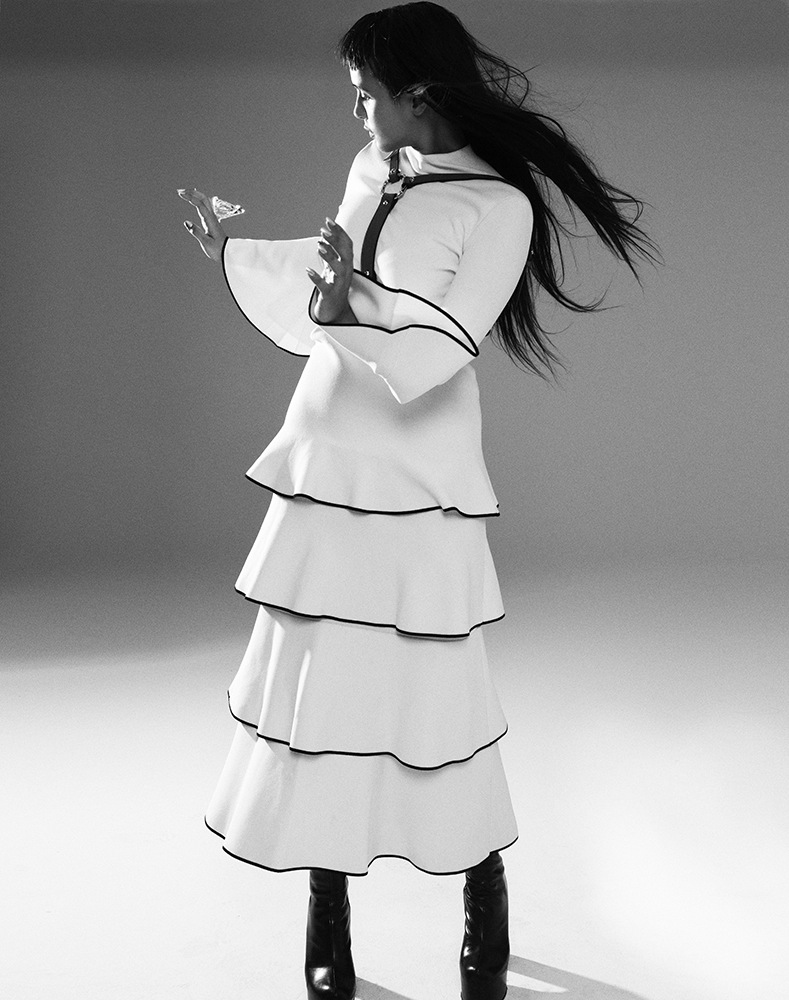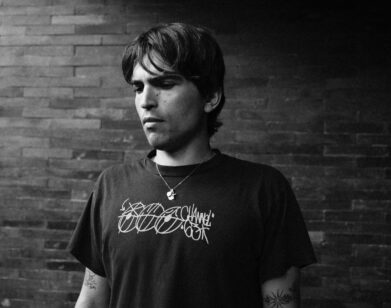Uncovering Young Magic’s Mystery
YOUNG MAGIC (MELATI MALAY) IN NEW YORK, MARCH 2016. PHOTOS: JACK WATERLOT/DE FACTO INC. STYLING: JEAN LUC FRANCAISE. HAIR: ADAM MARKARIAN. MAKEUP: NAM VO/JEDROOT. MANICURE: GERALDINE HOLFORD FOR DIO VERNIS/THE WALL GROUP. SPECIAL THANKS: GO STUDIOS.
For the first time in the duo Young Magic’s six-year history, Melati Malay wrote the beginnings of an album entirely on her own. Out this Friday, Still Life (Carpark Records) acts as Malay’s exploration of her Indonesian ancestry, fueled by the passing of her father. For one month, the 31-year-old returned to Indonesia, where she lived until she was 11, and began unraveling familial lore. “I had a lot of questions about the superstitions and traditions,” she says. “I wanted to get a grasp on how that might have affected me as an artist, my fascination with mystery, and how that’s shaped what this band has become.”
Upon her return to Brooklyn, where she’s lived for the last decade, she joined bandmate Isaac Emmanuel and three other musicians to translate her ideas into fully formed songs. “Lucien,” the LP’s first single, features original field recordings of a gamelan and faint echoes of foreign conversation are heard throughout the record. As a whole, Still Life is an experimental soundtrack that is as enthralling as it is enigmatic. We spoke with Malay, who was at her Greenpoint apartment, over the phone.
EMILY MCDERMOTT: I know the album was largely inspired by and written during your time in Jakarta. When was the last time you had been back since leaving after your childhood?
MELATI MALAY: Maybe two years prior. It had been a while. I was born and raised there, but going back as an adult, I had a totally different perspective; as a kid, it’s more of a mystery and you’re more oblivious to social or political things happening. I loved growing up there—it was really chaotic, strange, and mysterious. It’s kind of a lawless place, as well. Indonesia is 17,000 islands, or more, and Jakarta is one of the most densely populated cities in the world, so the entire spectrum of life can exist in this place. It runs the gamut of human experience. I think that chaos was something I was drawn towards and hence, maybe, why I moved to New York eventually. That fervor of collective energy—I always need to feel a little bit high and part of something larger than myself.
MCDERMOTT: What are some of the mysteries or superstitions you wanted to explore?
MALAY: When I was in Bali, they have this day called Nyepi, and the day before the festival they build effigies of monsters called ogoh-ogohs, which are then burnt. The next day everyone stays inside; you’re not allowed to go outside on the streets for 24 hours because it’s believed that evil spirits are flying over the island. It’s really enforced, no one is allowed outside—even foreigners and tourists are supposed to stay inside. It’s a strong belief that has stuck around. Making this album was kind of like making my own effigy—confronting demons or monsters and burning it by releasing it into the world.
MCDERMOTT: Can you talk about some of the demons and monsters that you think you confronted?
MALAY: I think it’s more the trauma of losing a parent. There’s an impossibility and a powerlessness—I’m going to be missing this person for the rest of my life and how do I deal with that? How do I accept it? Having my own set of meditation with this record, and pouring those feelings into this album, was the best way for me to do that.
MCDERMOTT: I read that you really delved into your family history. I’m curious as to what you may have learned?
MALAY: A lot more questions than answers. [laughs] There are some crazy stories about black magic happening right now with my family. I don’t know if I necessarily believe in it, but it’s very real to people in my family. I don’t really want to go into it, because I don’t want to make it worse. That was the biggest one.
But also how my father had met my mom: He grew up in Illinois in a small town and was always this mystery to me. Like how did he get from Illinois to the jungles of Indonesia in the ’60s? I found out that he left home when he was 16. He wanted to leave that town, so lied about his age and he joined the navy because he eventually wanted to get a university degree. He was in the Korean War and after that he traveled to Indonesia, where he met my mother. There were two statues in our house, always. They’re scary as a kid because they’re about as tall as a five-year-old. They’re really heavy and quite daunting, but they’re made of wood. I asked him about them—and I have no idea if this is true—but he said he was traveling in Borneo in Kalimantan and met the local Dayak tribe, which has been known to be headhunters. He wanted these statues, which they said were grave statues, so he traded his watch and cigarettes. Now I have these statues, which should probably be in a museum, in my house.
MCDERMOTT: When you were researching and discovering this information, what was the process like?
MALAY: Almost every day, in the morning, I rented this motorbike and had my phone and was recording. I was zooming around the place, seeing if I would run into something interesting. I would hear kids praying, and the gamelan, and I would just sit and listen and record. I would record people’s conversations in the market place, but it wasn’t until I got back to New York and fished through all these hours of recordings that I could place them. At end of “Lucien,” the first single, it’s a very static moment and the ringing of the metal from the gamelan was a perfect way to bring it in and have a celebratory feeling.
MCDERMOTT: What was the experience like when you recorded the gamelan originally?
MALAY: I was in Yogyakarta, where my family is from. I drove past this temple all the time and would just sort of sit there. They would see me and I would let them do their thing because there were young kids playing. Eventually I asked if I could sample each instrument, and they were really excited about it and let me do it.
MCDERMOTT: Your two previous records, Melt [2012] and Breathing Statues [2014], were written and recorded all over the world in many different places. How did the process change, or your feelings change, having this one grounded in only two places, Jakarta and New York?
MALAY: It was good for me because having it start in Indonesia brought focus to it; it ran a line through the whole process. When I got back to New York, I had this collage of information and ideas that were scattered and I wanted to flesh them out with friends. So I asked this producer from Detroit, Erin Rioux, who helped with some of the beats, and he was co-producing records with Isaac and I. I also thought there was female energy missing from it, even though I am part of it, so I enlisted my friend Kelsey Lu, a cellist, to play on the record as well.
MCDERMOTT: The press release about the album quotes you saying, “I’ve always felt like I’m some sort of hybrid existing in two worlds.” Could you talk a little bit about how the album addresses the idea of duality, or how you explore that through your music?
MALAY: When my father met my mother, he converted to Islam from an Irish Catholic background. As kids, growing up with these two different religions, celebrating both Christmas and Ramadan at home, that openness to all sorts of cultures and ideas has stuck with me. How that translates into the record is that I’m always searching for that tension between the two poles and finding some sort of harmony in between.
Personally I’m not religious at all. I think religion is valuable for some, but I like picking and choosing what traditions and ideas [to believe in or follow]. From all religions, there’s an underlying thread that we really all want the same things. I don’t think picking one, necessarily, is a wise thing to do. I think I see it as trying to make a place where there’s integration of ideas and openness towards people’s instincts and different cultures.
MCDERMOTT: Can you tell me about the name of the album, Still Life, as well? It isn’t the name of a track on the album, so I’m wondering where it came from.
MALAY: It kind of has a double meaning. “Still life” can be one version of yourself, still like a painting, but on the other hand means that you’re constantly recreating that version of yourself according to environmental, social, political influences in this world, where people constantly tell you who to pray to, what to buy into, and who your enemies should be. It’s my reaction to that. Life, and yourself within it, is constantly going to be recreated, so there’s no point in being steadfast in one ideology.
MCDERMOTT: Looking back on your experience writing this album, what is one of the biggest things you think you learned about yourself?
MALAY: I think having patience and giving yourself time to be still, to all of the process information we are bombarded with everyday. In this age, we’re constantly getting new information—new tragedies, new celebrations, new this, new that. Unless you have moments when you are still, where you are processing and reflecting, it will be overwhelming. It’s important to me to have a place where I can channel all of that and be a creator, and process that information into something that is new and hopefully something that’s beautiful.
MCDERMOTT: Is music your only channel for that, or do you find yourself doing other things as well?
MALAY: I have a little painting thing that I do, but I don’t show anyone. Painting is my own little personal joy, but definitely music is the main one.
MCDERMOTT: What kind of paintings?
MALAY: All these portraits. It starts off as people that I know, but always ends up looking like me, like a self-portrait.
MCDERMOTT: Can you tell me about the song “How Wonderful”? The sounds on that track really stand out to me.
MALAY: “How Wonderful” is one of my favorites, too. The lyrics are toward self-exploration and then sort of denying your role in ever having complete control of your life anyway. This is one of the darkest songs on the record. It was written at a time where I was having a lot of trouble saying goodbye to somebody that I didn’t want to say goodbye to, and then realizing that I don’t really have a choice in it all, that I just needed accept it and turn it into a place of self-reflection or be tormented with it forever.
STILL LIVE WILL BE RELEASED THIS FIRDAY, MAY 13, VIA CARPARK RECORDS. FOR MORE ON YOUNG MAGIC, VISIT THE DUO’S WEBSITE.







